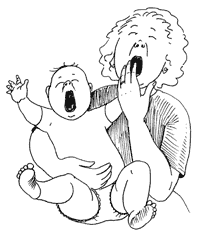STRANGE BUT TRUE- Yawning yarns: Not always a boring story

DRAWING BY DEBORAH DERR McCLINTOCK
Q. Most people know that babies yawn, as do neonates within minutes of birth and even fetuses in utero. Boredom, of course, can trigger yawning, which is socially contagious like laughter. What might people not know? –R. V. Winkle
A. Oddly enough, most of us physically enjoy yawning (sneezing, too), rating it 8.5 out of 10 on the hedonic scale, says psychologist Robert Provine in American Scientist. Yawn researcher Provine says he has become so associated with the subject that just his presence can set people who know him to yawning. Other eye-opening yawners are paratroopers before their first jump, Olympic athletes awaiting their event, a violinist about to go on stage, or a dog on the threshold of attack. Contrary to the old myth, breathing carbon dioxide won't induce yawning, nor will breathing oxygen-rich air inhibit it.
Right after waking, people both yawn and stretch; before bed they only yawn. The most extraordinary yawn– stretch linkage occurs in hemiplegics paralyzed on one side of the body due to brain damage from a stroke, who when yawning may automatically raise and flex their otherwise paralyzed arm as an "associated response."
Q. How on Earth did we humans beat the towering odds against us ever evolving in the first place? Asked another way, how long would it take a keyboard-equipped monkey to type a sentence by blind chance alone?–W. Shakespeare
A. In a new take on the old "infinite monkeys" routine, Clifford Pickover in A Beginner's Guide to Immortality imagines an indefatigable monkey pounding away, with the target sentence as "In the beginning, God created the heavens and the Earth." The phrase contains 56 letters, counting spaces and the period. Assuming a keyboard of 93 potential characters, then the monkey's chance of hitting the first correct character is 1/93, which he must do 56 times in a row: 1/93 to the 56th power (1/9356). This means the monkey would have to try more than 10100 times, on average, before hitting on the sentence.
"If the monkey pressed one key per second, he'd be typing for well over the current age of the universe," says Pickover.
Luckily, there's a better way: If after every trial, the monkey could somehow save the correct characters and try again only on the misses, mathematical analysis shows he'd need only around 400 trials to have a 50-50 chance of getting the sentence right. And the marvel here is that that's closer to how evolution works, producing remarkable results not by wholesale blind chance but by preserving useful random mutations while eliminating nonadaptive ones.
Q. If competitive "springboard diving" from 3 meters up or "platform diving" from a rigid platform 10 meters above the water (nearly 3 stories!) are too tame for you, have you ever tried "wild diving"? Lots of people have, and a few lived to tell about it. –F. Mingxia
A. In the early days of "wild" diving, lunatics vied to achieve the highest high dive, says Vincent Mallette in The Science of the Summer Games. At least one leaped 360 feet (110 meters) into the sea from the Graf Hindenburg and lived. In 1918, a Solomon Islander, defying gamblers who bet 10-1 he would die, survived a 205-foot (62-meter) plunge. His suit was ripped off and his body turned black-and-blue for weeks.
"But the odds are not good. Of the nearly 700 people who have jumped off the Golden Gate Bridge (admittedly not expert divers!), fewer than 2 percent survived the 240-foot (73-meter) drop. Today's competitive dives are never more than 10 meters, and scoring centers around the maneuvers performed during the dive and the grace of the entry," Mallette says.
Q. Name the sporting daredevils whose lives hang routinely on the following equation: MAXIMUM STRETCH LENGTH = W/K + THE SQUARE ROOT OF [(W x W)/(K x K) + (2 x W x L)/K]. –W. Hunting
A. Right, bungee jumpers, and before they go jump off a bridge, tower or hot-air balloon, they (or the jump master) had better know their weight precisely. It's the W in the above equation (K = the cord's stiffness, L = initial cord length), and if you plug in the numbers, you'll see that a jumper who's twice as heavy will stretch the cord by at least 40 percent more– no problem so long as cord mechanics and length are well chosen for the site, a potential tragedy otherwise. (Don't try this! Don't try this!)
Just for fun, picture a jump– you accelerate 32 feet per second per second (1 G), nearing 60 mph in 2.5 seconds. Having fallen maybe 100 feet, you're nearing the end of your bungee tether– rubber strands wrapped in woven nylon– then you'll stretch maybe another 100 feet before... boooiiinnnggg! Time to zoom back up.
You won't return all the way to your starting height because energy is lost to air resistance and friction in the cord or cords. So after a couple more bounces, you'll be bounced out, left hanging in midair.
Just weight-ing to jump safely again.
Send Strange questions to brothers Bill and Rich at [email protected]
#